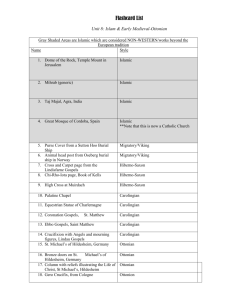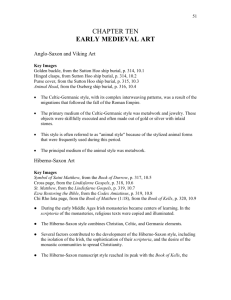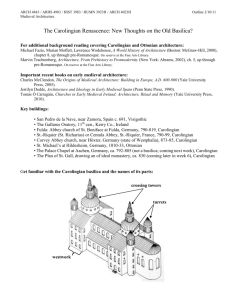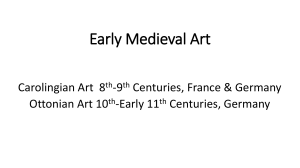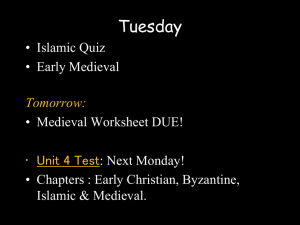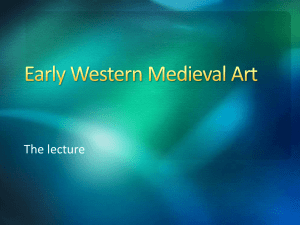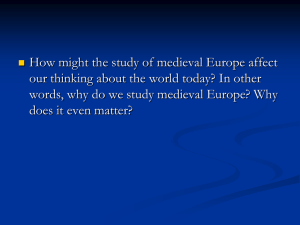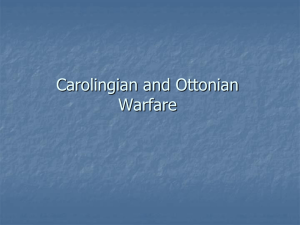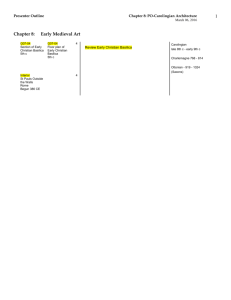Early Medieval Art
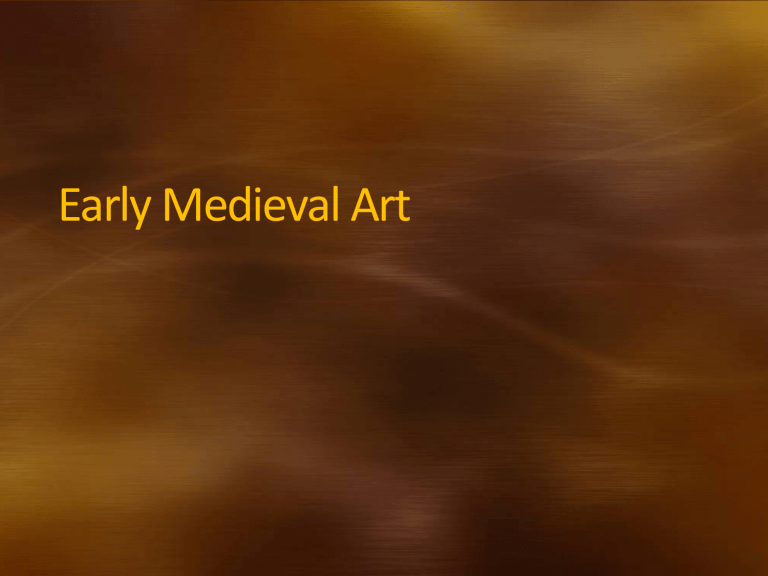
Early Medieval Art
Who, When, and Where
Civilization Date
Hiberno-Saxon 6 th -8 th C.
Viking 8 th -11 th C.
Carolingian
Ottonian
Location
British Isles
Scandinavia
8 th -9 th C.
France, Germany
10 th -Early 11 th C.
Germany
Key Ideas
The Migration period in the Early Middle Ages featured portable works that were done in the animal style.
Characteristics of Early Medieval Art include horror vacui and interlacing patterns
Art at the court of Charlemagne begins the first of many western
European revivals of ancient Rome
Ottonian art revives large scale sculpture and architecture
Vocabulary
Animal Style- a medieval art form in which animals are depicted in a stylized and often complicated pattern, usually seen fighting one another
Cloisonné- enamelwork in which colored areas are separated by thin bands of metal, usually gold or bronze
Cloister- a rectangular open-air monastery courtyard with a covered arcade surrounding it
Codex- a manuscript book
Vocabulary
Colophon- an inscription at the end of a manuscript containing relevant information about its publication
Gospels- the first 4 books of the New Testament
(chronicle the life of Jesus
Christ)
Horror Vacui- type of artwork in which the entire surface is filled with objects, people, designs, and ornaments in a crowded congested way
Vocabulary
Psalter- book of
Psalms (sacred sung poems), of the Bible
Scriptorium- place in a monastery where monks wrote manuscripts
Westwork- a monumental entrance to a
Carolingian church in which two towers flank a lower central entrance
Illuminated Manuscripts:
Illuminated Manuscripts https://www.youtube.com/watch?v=1aDHJu9J10o
Anglo Saxon Hoard Found http://www.youtube.com/watch?v=eQNUdMets6I
Characteristics of Saxon Art:
Medieval Britain- 6 th – 8 Th C.
The discovery of a hoard of Anglo-Saxon gold and silverwork in 2009 changed the historical perspective/knowledge of the
Anglo-Saxon kingdoms of Medieval Britain
Sutton Hoo ship burial (1939) revealed some of the richest works from this period.
Artistic styles include:
Cloisonne
Horror vacui
Animal style
Interlacing patterns
Portable objects
Elaborate symmetry with animals and geometric designs
Saxon Art: Purse Cover from Sutton
Hoo Ship Burial, 600-650
Ship burial, possibly for King Raedwald of East Anglia
Purse cover- the metal was backed by ivory or bone, which desintigrated along with the leather portions of the bag
Animal style (hawks attacking ducks)
Animals bite the heads of the men they flank
Interlacing patterns, ornamental design
Legs and arms intertwined
Cloisonne technique
Characteristics of Hiberno-Saxon Art:
Hibernia = ancient name for Ireland
Hiberno-Saxon – Art of the British Isles, 6 th – 8 th C.
Main artistic expression is ILLUMINATED
MANUSCRIPTS
Artistic Styles/Themes include:
Interlacing patterns horror vacui
Harbor animals in combat patterns (??)
Animal style
Illuminated texts:
Open with huge initials, highly decorated
Bright colors, painted by highly skilled artists
Hiberno-Saxon Art: Saint Matthew from the Book of Lindisfarne, 700
Illuminated Manuscript Gospel Book
Saint Matthew seated on a cushioned bench writing his book of the Bible
Man behind curtain- God? Moses?
Christ?
Matthew’s symbolic angel behind him
Words= “Image of a Man”
Byzantine influence:
Greek words “Saint Matthew” in
Latin
Angel’s hand covered
Flattened linear elements
Colophon: the gospels were painted and inscribed by Bishop Eadfrith of
Lindisfarne
Hiberno-Saxon Art: Chi-Rho-Iota Page from the
Book of Matthew in the Book of Kells, 800
Lavish, richly decorated book
Very complex designs
Interlacing patterns
The initials are the dominant motif
Chi and Rho = the first two letters of
Christ’s name in Greek (Christos); often represented as a monogram in
Christian art
Created by monks in a Scriptorium
Painted on vellum
Very expensive material
Characteristics of Viking Art:
Population growth in Scandinavia resulted in
Viking invasions throughout Europe.
Viking artists emphasized animals and spirals and elaborate interlacing patterns
Mostly applied art, ie FUNCTIONAL
Sword hilts, belts, buckles, etc.
Art/symbols/designs were engraved on functional objects
Animal style with horror vacui
Viking Art: Animal Head Post from the Oseberg Ship Burial, 834
Part of a ship burial for two high ranking women in the Viking court
Snarling mouth, wild staring eyes, flaring nostrils
Head- filled with interlacing animal patterns
Purpose = unknown; possibly prow of a boat or used in a procession
Characteristics of Carolingian Art:
Carolingian Art = the art of Charlemagne (and the time period, of course)
France and Germany, 8-9 th C.
First revival of classical art from the ancient world (this will be a theme throughout
European art from now on…yay?)
Charlemagne
Wanted to be the emperor of a “New Rome”….so he copied all Rome’s stuff. Like…
Bath houses, theatres, forum
Roman imagery was used on coins and in architecture
(and everything in between)
Characteristics of Carolingian Art:
Carolingian Churches
Elaborate westworks (entrance, chapel, two towers)
Monastic buildings housing…ahem…monks/nuns. (in entirely self sufficient communities- we don’t want these guys and gals being tempted with sin by interacting with
“the public”)
Cloisters- open air courtyards in monasteries
All these churchey buildings were usually placed together…near the church.
Some murals and mosaics were created, but nobody really liked them. Let’s focus on the manuscripts and paintings! (blending Byzantine and Roman styles, of course!)
Carolingian Art: Lorsch Gatehouse, 760,
Lorsch Germany
Part of the Lorsch Abbey
Placed before the entrance to the monastery
3 arched openings divided by engaged columns (Roman)
Fluted pilasters (fake columns) on second story
Chapel on upper story
Turrets (tower) on left and right stairwell
Carolingian patterns with brick
Carolingian Art: Equestrian Statue of
a Carolingian Ruler, 9
th
C.
Imperial imagery- holding an orb (symbol of the world)
Influenced by Roman equestrian statutes (did you guess Marcus Aurelius??)
Rider
Larger than horse
Upright
No natural movement
Charlemagne? Charles the
Bald?
Carolingian Art: Utrecht Psalter, 820-832
A Map of Middle Earth
I mean…a book of
Psalms
Highly detailed drawings of the psalms from the Bible
Monochrome (brown and white)
Literal translation of the psalms
Stylized charactersdisplays agitation, violence, etc.
Carolingian Art: Palatine Chapel, 792-805,
Aachen, Germany
Carolingian Art: Odo of Metz, Palatine
Chapel, 792-805, Aachen, Germany
Architect- Odo of Metz
Was originally part of Charlemagne’s Palace of Aachen
Sort of modeled after San Vitale
Capitals and columns are Roman spolia from Ravenna
Dome composed of spherical triangles
Charlemagne’s throne is in the gallery “halfway between heaven and earth” (high opinion of himself, hmm??)
Largest arches are on second floor, not the first
(unusual)
Columns that fill the arches don’t support it- they just fill the space
Carolingian Art: Plan of St. Gall, 820
Medieval architectural drawing of a monastic compound
Ideal, self-sufficient monastic community of 3000 people
Church in the center (literal and symbolic)
Cloistered monks only leave to work in the fields
Daily activities revolve around the cloister- sleep, eat, etc.
Workshops for making leather, pottery, etc.
Houses made of timber, serfs live with their animals
Typical Carolingian church- 2 apses, elaborate westwork
No evidence that these plans were ever made into an actual building
Characteristics of Ottonian Art:
Germany, 10-early 11 th C.
Influenced by Roman and Early Christian art
Large stone churches, bronze doors
Common themes include:
Interior arches and windows that do not line up atop each other
Flat, undecorated walls
Large black spaces
Arches with red and cream alternating stones
Ottonian Art: Abbey Church of St. Michael’s,
Hildesheim, Germany, 1001-1033
Church with 2 transepts, each with crossing towers and 2 stair turrets
Lateral entrances through side aisles
External side aisles act as narthexes (lobbies) to the building
Support of nave arcade alternates pairs of columns and square piers
Windows in clerestory do not line up with arches (10 windows/9 arches)
Transept arch is subdivided by 2 tower round arches & 4 smaller second story arches
Ottonian Art: Bishop Bernward Doors, Saint
Michael’s, 1015, Hildesheim, Germany
Two 15-feet tall bronze doors
“Imperial” overtones- Pantheon originally had bronze doors (they are gone) and Aachen has plain bronze doors (Charlemagne's chapel)
Left Door: Fall of Man
Right Door: Redemption of Man
Rectangular panels, few human figures, bare landscapes, emphasis is placed on lively gestures
Bony figures with emphasis placed on their hands, feet, and heads
http://www.youtub
e.com/watch?v=__ pl88NO9Jw
Expulsion from the Garden of Eden
Ottonian Art: Gero Crucifix, 970,
Cologne Cathedral
Return of large, monumental sculptures
Life-sized, wooden; painted and partially gilded
Rounded human form
Human suffering crucifixion; earliest example of art depicting the Crucifixion with a dead Christ
Commissioned by
Archbishop Gero fro the cathedral in Cologne,
Germany
Considered “Late Ottonian” or “Early Romanesque”
